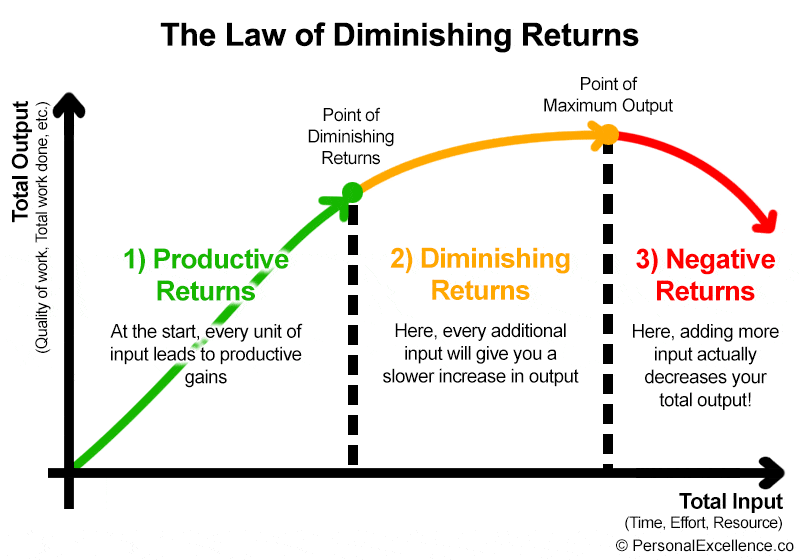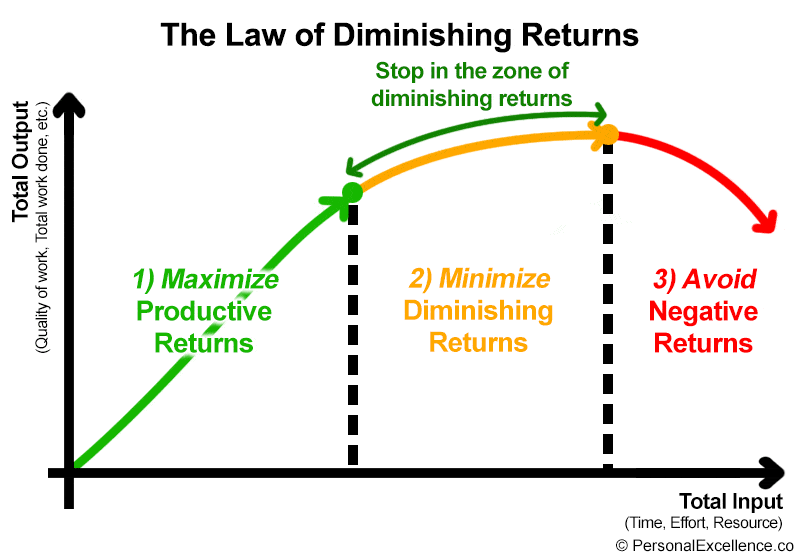
Hi everyone! Today I want to share a concept that is very applicable to personal growth: the law of diminishing returns. It teaches us how to maximize our output for our time and effort, and to get the most out of life.
I learned about it while studying economics in school, and here’s what it says:
The law of diminishing returns state that as more units of a variable input (like time, effort) are added to a productive process, the additional output (or benefit) from each new unit will eventually decrease.[1]

(Image)
Let’s say you have a cornfield and you want to increase your corn yield with fertilizer.
- Adding one bag of fertilizer significantly boosts your crop yield.
- Adding a 2nd and 3rd bag increases your yield further, by roughly the same amount.
- Adding a 4th bag still increases it but by a smaller margin. Each additional bag after that contributes less and less to the total yield, even though it’s the exact same type of fertilizer! This smaller yield increase is called diminishing returns.
- If you keep adding more fertilizer beyond diminishing returns, the field becomes overfertilized and you get a decrease in total corn yield! This is called negative returns.
See graph below:

(Image: Personal Excellence)
Diminishing Returns in Our Life
Diminishing returns can actually be observed in different areas of our life. Consider these examples:
- Work. The initial hours of a work day are usually the most productive. In the later hours, productivity starts to decline as our energy decreases. At a certain point, it results in burnout.
- Social media. While using social media can feel fun and enjoyable at first, after some time it becomes less enjoyable. Using it for 2, 3, 4 hours can feel draining and sucks up our productivity.
- Learning. The first book we read on a topic is usually the most helpful as we learn its fundamental concepts. Reading 10 more books on the same topic may continue to be helpful. But to read 20, 30, or 50 books on the exact same thing? It becomes repetitive and offers diminishing gains (unless the book is extremely well-written with unique value-add to the topic).
- Meetings. Having meetings every week can improve clarity and collaboration at work. But having too many meetings adds little value, eats into productive work time, and creates mental drain.
As a writer, I typically have high output during the first 2-3 hours of my writing session. Beyond a certain point, I’m editing and rewriting points but not making much gains. That’s my point of diminishing returns.
For my site content, it’s helpful for my readers when I write articles on a new topic. But to write 10, 20, 30 articles on the exact same topic without any new insight or ideas? It leads to diminishing returns, which is why I do not write repetitive content even though it is common to do so for self-help blogs.
Can you see situations with diminishing returns in your life?
What We Can Learn From This 💡
The law of diminishing returns teaches us some important things:
- Firstly, more isn’t always better. Beyond a certain point, adding more time, effort, or resources leads to a slower growth in output. And beyond that, it leads to negative gains.
- Secondly, it’s important to find the optimal point that gives the best return. By strategically allocating our time, effort, and resources, we can achieve greater results without increasing input.
- Thirdly, rest and variation can help us sustain high levels of productive output over time.
This is true whether in work, relationships, health, or skill improvement. E.g., with relationships, there are diminishing returns from having too many meetups a week — it takes away from productive work time and me time. With health, there are diminishing returns with each health protocol you follow — it is better to branch out and try other approaches that can jumpstart your progress.
At the heart of it, the law of diminishing returns is a reminder for us to work smarter and to aim for better results with less wasted effort.
With each goal you are working on (whether it’s work, health, exercise, relationships, etc.), you want to focus on the steps where you can get the most returns, and to stop and change your action when you reach diminishing returns.

Stop in the zone of diminishing returns, when payoff is not justified by added input (Image: Personal Excellence)
For example:
- Studying: Studying for 2 hours can help you learn a lot, but studying for 6 hours straight can lead to reduced retention and smaller gains per hour. Take short breaks to move around, rest, and recharge first, and then return with better focus.
- Creating content: When creating a report, you spend 2 hours creating a solid draft and another hour refining it. In the 4th hour though, you are busy nitpicking details that have no actual impact on the output. That means it’s time to wrap up and move on.
- Improving health: Say you are optimizing your health. You tried a bunch of supplements and they either had minor or no noticeable effect. Here, branch out to try new things. Try sauna, castor oil, grounding, switching to a whole food diet, herbs, and exercise. Research supplements that target different areas of health. Join health communities to get fresh ideas to jumpstart your progress.
- Growing blog: Lastly, you’ve been guest posting and it has given you healthy traffic gains. However, it’s now harder to find sites to guest post on and the traffic gain from this strategy has also diminished. At this point, it’s better to pivot to other strategies, such as Tiktok, YouTube, or Pinterest.
Managing the Law of Diminishing Returns: How To Maximize Productivity and Gains 📈
So how can you maximize productive gains and minimize diminishing returns while spending the same time and effort? Very importantly, how do you avoid negative gains? Here are my 7 tips.
- Recognize when you are getting diminishing returns.
- Be aware when you are entering the zone of diminishing returns. Clear signs are when you make slower progress, you get less gain per input, the quality of the task doesn’t noticeably improve, or you feel mentally fatigued.
- For quantifiable goals (e.g., growing subscribers, sales), track and measure to know when diminishing returns kick in.
- Work in strategic time blocks.
- Identify the times of the day when you are most productive, and design your work day around these time blocks. Try to spend these productive hours on the most important tasks.
- Focus on the 80/20.
- Focus on high-impact strategies. With every goal, adopt strategies that give you the best return. When progress slows down, adjust your approach and adopt the next best strategy.
- Prioritize high-impact tasks. Every day, focus on the tasks that give you the highest impact in terms of your end goal. Ask yourself, “Is this the best use of my time? Is this the most meaningful thing I can do now?”
- Avoid fine-tuning to oblivion. When working on a task, you may fine-tune things to oblivion. Perfectionism is good, but save it for tasks that really matter. For most tasks, do them to a good-enough quality and move on. Read: How To Overcome Perfectionism (series)
- Allow yourself to rest. Know that you are the most productive when your energy is high, not just when you’re at your desk. Rest and rejuvenation are vital for restoring productivity.
- Take steps to recover cognitively before returning to high-level tasks. If possible, get a change in environment. Try to take proper breaks such as going for a walk, practicing self-care, watching videos you enjoy, or spending time with a loved one.
- Have restorative off days where you do something different from your usual routine (e.g., a weekend trip, an excursion) and recharge your mind and spirit.
- Switch things up. Switch between different tasks to keep engagement high. For example:
- Work: Switch between high-level tasks when you are recharged and low-level tasks (emails, admin) when you feel fatigued.
- Writing a book: Switch between writing different chapters, designing the book cover, and creating the marketing plan.
- Know when to stop or change action. Upon entering diminishing returns, monitor your progress and decide when to stop or pivot. Ask yourself, “Am I still getting good gains, or am I getting diminishing returns?” If additional effort brings minimal gains, and the payoff is not worth it, it might be time to take a break, move on to the next task, or change your approach.
- Get feedback where possible. Avoid being locked into tunnel vision by regularly engaging others in what you’re doing. If you work in a company, involve your co-workers and manager to get their feedback. If you’re a solo creator, you can talk to friends and family, or share your ideas with industry peers and on forums. This prevents wasted effort from working on things that are not viable.
Final Word
Finally, regularly consider your goal in the context of other goals and priorities. Even if a goal is giving you good gains now, it may be causing diminishing gains in other areas, and as such your objective may not be to maximize these gains.
For example, perhaps you are getting good financial gains and opportunities at work, but it is causing diminishing gains in your fulfillment and personal life (e.g., health, family). Here you may decide to switch focus to your personal life and cut back on your time spent at work, even though you are growing work-wise.
Case in point: Patrick Dempsey was a leading actor and the highest paid cast member on Grey’s Anatomy when he suddenly left the role in April 2015. The show was doing extremely well and in its 11th season then. So why did he leave? Even though Dempsey was experiencing great career growth and earning great money, he was burned out by the 10-month, 15-hour-a-day filming schedule. He said in an interview, “I think after a certain period of time, no matter how much money you make, you want control out of your own schedule.”[2]
His marriage was also a driving point as his wife had filed for divorce months earlier in January 2015. “Our marriage was not something I was prepared to let go of,” he said. Knowing their marriage could end was a “scary” feeling. Through couples counseling, they reconciled and called off their divorce in 2016.[3]
Know that there is a larger context which is your end objective and your other priorities in life. Your priorities can always change based on what’s going on in your life. You have to evaluate if you are still getting meaningful gains from what you are doing (e.g., money, happiness, fulfillment), or if it’s more rewarding to switch focus to something else (such as health, relationships, or family).
To You
The next time you engage in a task or activity, ask yourself:
- Am I getting good gains, or am I getting diminishing returns?
- Is the payoff justified by the additional input?
- If the payoff is not worth it, it may be time to put a stop to this task or activity. Take a break, move on to the next task, or change your approach.
Learn to spot diminishing returns in your life and direct your effort accordingly to areas where you can get the most returns. This way you can get more out of life with the same time, effort, and resources. 🙂
Related posts:
- How To Overcome Perfectionism: A Complete Guide
- The Bike Shed Effect: How To Spend Time on the Right Things
- The 80/20 Principle: How To Achieve More With Less In Life (series)
Quick Note: I’m excited to share that the 2025 edition of Live a Better Life in 30 Days (30DLBL) is now out! 30DLBL is my 30-day program to live a better life and it’s a great tool to do a life audit, set goals, and move your life to a new trajectory. Here’s a comment from reader Sam:
“After working on 30DLBL for just a few days, I know what I have been lacking; the ability to envision my dreams and come up with a plan to achieve them. While my current goals may change with time, I feel more confident and in control knowing that at least, for now, I know where to focus my efforts.
Thank you so much Celes for creating this truly transformative, easy to follow guide! This is a game changer for anyone feeling stuck in a cycle of similar patterns and behaviours.”
If you’re experiencing diminishing returns from working on your personal growth from self-help resources, 30DLBL is a great way to jumpstart your growth. Read about 30DLBL here, or if you are a past buyer, learn how to get access here! Any questions? Let me know here. 🙂